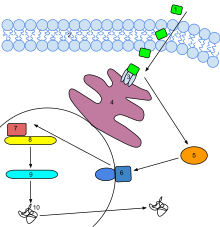
Ethylene (CH
2=CH
2) is an unsaturated hydrocarbon gas (alkene) acting as a naturally occurring plant hormone.[1] It is the simplest alkene gas and is the first gas known to act as hormone.[2] It acts at trace levels throughout the life of the plant by stimulating or regulating the ripening of fruit, the opening of flowers, the abscission (or shedding) of leaves[3] and, in aquatic and semi-aquatic species, promoting the 'escape' from submergence by means of rapid elongation of stems or leaves.[4] This escape response is particularly important in rice farming.[5] Commercial fruit-ripening rooms use "catalytic generators" to make ethylene gas from a liquid supply of ethanol. Typically, a gassing level of 500 to 2,000 ppm is used, for 24 to 48 hours. Care must be taken to control carbon dioxide levels in ripening rooms when gassing, as high temperature ripening (20 °C; 68 °F)[6] has been seen to produce CO2 levels of 10% in 24 hours.[7]
- ^ Lin Z, Zhong S, Grierson D (2009). "Recent advances in ethylene research". Journal of Experimental Botany. 60 (12): 3311–3336. doi:10.1093/jxb/erp204. PMID 19567479.
- ^ Bakshi, Arkadipta; Shemansky, Jennifer M.; Chang, Caren; Binder, Brad M. (2015). "History of Research on the Plant Hormone Ethylene". Journal of Plant Growth Regulation. 34 (4): 809–827. doi:10.1007/s00344-015-9522-9. S2CID 14775439.
- ^ Jackson MB, Osborne DJ (March 1970). "Ethylene, the natural regulator of leaf abscission". Nature. 225 (5237): 1019–22. Bibcode:1970Natur.225.1019J. doi:10.1038/2251019a0. PMID 16056901. S2CID 4276844.
- ^ Musgrave A, Jackson MB, Ling E (1972). "Callitriche Stem Elongation is controlled by Ethylene and Gibberellin". Nature New Biology. 238 (81): 93–96. doi:10.1038/newbio238093a0. ISSN 2058-1092.
- ^ Jackson MB (January 2008). "Ethylene-promoted elongation: an adaptation to submergence stress". Annals of Botany. 101 (2): 229–248. doi:10.1093/aob/mcm237. PMC 2711016. PMID 17956854.
- ^ Dahll, R.K. (2013). "Ethylene in the Post-Harvest Quality Management of Horticultural Crops: A Review". Research and Reviews: A Journal of Crop Science and Technology. 2 – via Researchgate.
- ^ External Link to More on Ethylene Gassing and Carbon Dioxide Control Archived 2010-09-14 at the Wayback Machine. ne-postharvest.com